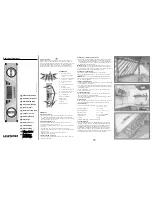
SKU 03192
Page 4
Laser Level Accuracy
This laser level is accurate to within one inch at 120 feet. If you are unsure of the
accuracy of this particular unit, you can perform a “two peg test”.
Two Peg Test
Drive a wooden peg in the ground. Measure 50 feet and mark the spot. Measure
another 50 feet and drive another wooden peg in the ground. Set up your Laser
Level on a solid, flat surface (stool, sawhorse) at the halfway mark (50’). Have
someone hold a board (vertically) on top of one of the pegs, marking the laser
spot center on the board. Record the distance from that spot to the top of the peg.
Repeat the procedure with the other peg. The difference in height of the two is
the difference in height of the two pegs (See FIGURE 1).
Set up your level above one of the pegs and sight on the opposite board’s mark.
Since you have already determined the difference, you know what the level
should read. If it is off, adjust the Adjusting Knob to compensate. That amount of
compensation is where you should adjust your level to before each use.
For example: FIGURE 2 shows a situation within accuracy tolerance. The level
is only off 1/2” at 100 feet (based on your deductions of a 36” difference). If it had
been off 2”, then you would have to adjust the Adjusting Knob a quarter turn
counterclockwise to compensate. A full turn changes the reading by 8” at 100’.
If the Laser is off 1” at 100’, then it will be out one quarter inch at 25’ and 1/2” at
50’.
Note: Be assured that the beam itself is always perfectly straight.
FIGURE 1
FIGURE 2
Elevation difference from top to bottom pegs = 36 inches
The reading is 1/2” below what it should be, (for a 36 inch difference in
elevation) which means the level reads 1/2” low at 100 feet.
48”
50’
50’
12”
44”
100’
7-1/2”
Brought to You by Augusta Flint
















